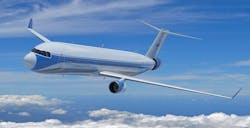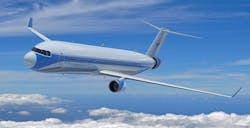NASA taps Aurora to assess electric airliner design with novel propulsion system
MANASSAS, Va. National Aeronautics and Space Administration (NASA) officials have contracted Aurora Flight Sciences in Manassas, Virginia, to evaluate the Single-aisle Turboelectric Aircraft with Aft Boundary Layer propulsion (STARC-ABL) aircraft concept. Designed to yield substantial fuel efficiency benefits, the NASA STARC-ABL aircraft is a subsonic commercial aircraft concept with conventional underwing gas-turbine engines and a ducted, Boundary Layer Ingesting (BLI) tailcone propulsor driven by a turboelectric propulsion system.
Aurora, known for innovative electric aircraft designs and high-performance aircraft for commercial applications, is currently leading the development of the Defense Advanced Research Projects Agency (DARPA) XV-24A LightningStrike, a 12,000-pound hybrid-electric aircraft with 3 megawatts (MW) of electric power driving 24 electric fans. Aurora recently flew a fully autonomous, battery-powered subscale version of the XV-24A, which also serves as the basis for Aurora's work on urban mobility platforms. In April 2017, Aurora was selected as one of Uber's industrial partners for the UBER ELEVATE program.
Aurora is also developing the D8, a commercial airliner design for the 150- to 180-seat market. Using composite structures, boundary layer ingestion, and high levels of autonomy, the D8 can provide up to 50 percent reductions in fleet-wide fuel burn over designs currently in use. The D8 is being developed through the FAA CLEEN II program, the NASA New Aviation Horizons program, and Aurora internal funding.
The award will leverage Aurora's lessons-learned across this diverse electric aircraft portfolio to assist NASA in validating the system level performance of the STARC-ABL aircraft.
Related Blog: Boeing doubles down on all-electric and autonomous aircraft
Aurora Flight Sciences is an innovative technology company which strives to create smarter aircraft through the development of versatile and intuitive autonomous systems. Operating at the intersection of technology and robotic aviation, Aurora leverages the power of autonomy to make manned and unmanned flight safer and more efficient.
Headquartered in Manassas, Virginia, Aurora operates production plants in Bridgeport, West Virginia, and Columbus, Mississippi, has Research and Development Centers in Cambridge, Massachusetts, Dayton, Ohio, and Mountain View, California, and a European office, Aurora Swiss Aerospace, located in Luzern, Switzerland.
Search the Aerospace & Defense Buyer's Guide
The go-to resource for Intelligent Aerospace technology news & information:
Covering key topics
Across all market segments
Subscribe to the free Intelligent Inbox e-newsletter
Subscribe to receive all the latest aerospace technology news & information, delivered directly to your e-mail inbox twice a week (Tuesdays and Thursdays). Sign upfor your free subscription to the Intelligent Inbox e-newsletter at http://www.intelligent-aerospace.com/subscribe.html.
Connect on social media
Keep pace with aerospace innovation and opportunities via your favorite social media channels. Connect with Intelligent Aerospace on Twitter (@IntelligentAero), LinkedIn,Google+, and Instagram.



